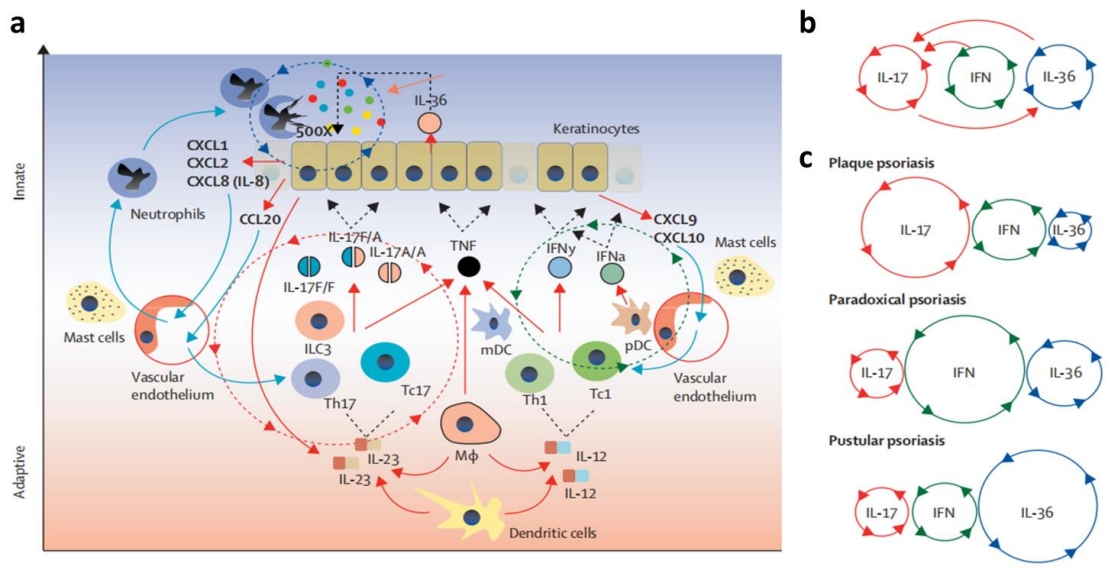
Publication Frequency
Quarterly since 2025
Journal Articles
Search
Search scope
Journal Center
Asia Pacific Academy of Science Pte. Ltd. (APACSCI) specializes in international journal publishing. APACSCI adopts the open access publishing model and provides an important communication bridge for academic groups whose interest fields include engineering, technology, medicine, computer, mathematics, agriculture and forestry, and environment.
Volume Arrangement
2025
Featured Articles

Psoriasis is a common, chronic, and inflammatory skin disease. Macrophages account for about 61.3% of the inflammatory cells infiltrating psoriatic lesions. Modulating macrophage polarization, inhibiting their infiltration, and targeting the secretion of inflammatory factors and associated inflammatory pathways by these cells can alleviate psoriasis symptoms and inflammation. Moreover, nanomaterials as novel drug carriers, offer unique advantages such as large surface area, easy modification, high biocompatibility, good biodegradability, enhanced systemic adsorption, etc. Nanomaterials have great potential for efficient drug delivery and release, as well as improving therapeutic efficacy while reducing adverse effects. By systematically addressing the role of macrophages in psoriasis pathogenesis and the potential of nanomaterials in treating psoriasis through modulating macrophages, this review enhances our understanding of the disease mechanism and holds promise for novel therapeutic breakthroughs and advancements in the future treatment of psoriasis.
LncRNA MATN1-AS1/miR-200c-3p/HAS-2 AxisModulates Proliferation, Invasiveness, Migration andEpithelial-Mesenchymal Transition of Colorectal CancerCells
Article ID: 3517
Vol 39, Issue 1, 2025
DOI: https://doi.org/10.23812/j.biol.regul.homeost.agents.20253901.3
Vol 39, Issue 1, 2025
Received: 19 October 2022; Accepted: 28 November 2022; Available online: 16 January 2025; Issue release: 31 January 2025
Download PDF
Abstract
Background: The Long noncoding RNAs (lncRNAs) have been recognized as pivotal regulators in the development of colorectal
cancer (CRC). In this study, we aim to evaluate the impact of lncRNA matrilin 1 (MATN1)-Antisense RNA 1 (AS1)/micro RNA
(miRNA, miR)-200c-3p/hyaluronan synthase-2 (HAS-2) axis on CRC cells and in vivo CRC model.
Methods: The expression levels of LncRNA MATN1-AS1 in CRC tissues were assessed utilizing the Gene Expression Profiling
Interactive Analysis (GEPIA) platform. The expressions of LncRNA MATN1-AS1 and miR-200c-3p were validated through
reverse transcription quantitative polymerase chain reaction, while HAS-2 protein and epithelial-mesenchymal transition (EMT)-
related protein expressions were examined using western blot analysis. The enrichment of lncRNA MATN1-AS1 and miR-200c-
3p was evaluated using RNA Binding Protein Immunoprecipitation (RIP). The binding sites between miR-200c-3p and lncRNA
MATN1-AS1 or HAS-2 were predicted by StarBase and confirmed through dual-luciferase reporter assay. Additionally, colony
formation assay was performed to assess CRC cell proliferation. Transwell migration assay and invasion assay were conducted to
evaluate the migratory and invasive abilities of CRC cells. An in vivo model was established by subcutaneous injection in BALB/c
nude mice, while lung metastasis models were created through caudal vein injection. Immunohistochemistry was employed for
the detection of HAS-2 protein in vivo.
Results: The expression of LncRNA MATN1-AS1 was found to be upregulated in both CRC tissues and cells. Subsequently,
dual-luciferase reporter assay was performed to demonstrate the interaction between miR-200c-3p and lncRNA MATN1-AS1,
which was further confirmed by RNA immunoprecipitation (RIP) assay. Suppression of miR-200c-3p rescued low CRC cell
proliferation, migratory and invasive abilities. EMT caused by the knockdown of lncRNA MATN1-AS1. HAS-2 is identified as
a target that is negatively regulated by miR-200c-3p, highlighting a critical interaction within the CRC molecular landscape. As
for in vivo detections, tumor weight and volume were suppressed via the downregulation of lncRNA MATN1-AS1. Additionally,
lncRNA MATN1-AS1 downregulation inhibited lung metastasis and suppressed HAS-2 protein levels.
Conclusion: The MATN1-AS1/miR-200c-3p/HAS-2 axis was shown to regulate CRC cell proliferation, invasiveness, migration,
EMT, and tumorigenesis in vivo.
Keywords
long noncoding RNA MATN1-AS1; MicroRNA-200c-3p; hyaluronan synthase 2; colorectal cancer
References
Supporting Agencies
Copyright (c) 2025 Dengke Fu,Yang Chen,Dongkui Xu

This site is licensed under a Creative Commons Attribution 4.0 International License (CC BY 4.0).
Editor-in-Chief

Medical Genetics, University of Torino Medical School, Italy
Co-Editor-in-Chief

Department of Biomedical, Surgical and Dental Sciences, University of Milan, Italy
Indexing & Archiving
News & Announcements
2025-02-01
In addition to the first issue that has already been published by the original publisher, there will be four more issues released this year, with scheduled publication dates in March, June, September, and December respectively.
2025-01-21
Starting from Volume 39 Issue 2 (2025), the ownership of Journal of Biological Regulators and Homeostatic Agents (ISSN: 0393-974X (P); 1724-6083 (O)) will be transferred from Biolife Sas to Asia Pacific Academy of Science Pte. Ltd. As of 21 January 2025, authors should make submissions to the new journal system and follow the author guidelines. Asia Pacific Academy of Science Pte. Ltd. will take over the publication of manuscripts being processed.

